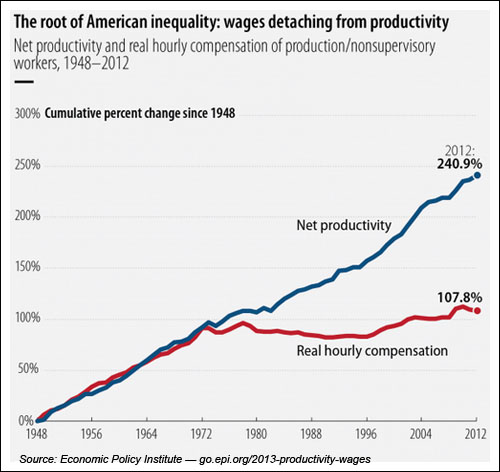OPINION
Raise minimum wage to begin addressing income inequality
(Jan. 30, 2014) — Last week, 32 House Democrats joined Jesslyn Farrell (D-Seattle) in proposing to increase our state’s minimum wage to $10 in 2015, $11 in 2016, and $12 in 2017. It is about time. Our minimum wage has steadily fallen away from its high point in 1968. That was 35 years ago. And yet, worker productivity has almost doubled since then.
Up to 1968, increases in the minimum wage kept up proportionately with productivity increases. That made sense, as the gains in productivity were in that way equitably shared between employers and employees. Workers could increase their everyday purchases and businesses could increase their investments (or just enjoy greater profits). But after 1968, minimum wage increases tailed off, while productivity continued to increase.
In fact, the minimum wage has actually fallen in value when you take into account inflation. The value of the minimum wage 35 year ago, in today’s dollars, was just about $11 an hour. So even though Washington has the best statewide minimum wage in the country ($9.32), a worker earning the minimum wage here starts out $1.68 behind what she would have made in 1968.
A bit of history is helpful: In 1998, voters passed Initiative 688, which increased the minimum wage from $4.90 to $5.70 in 1999 and $6.50 in 2000 and linked increases thereafter to inflation. In the two decades leading up to Washington’s minimum wage policy change, the bottom 10 percent of income earners, who earned near or at the minimum wage, experienced an 8 percent decline in real earnings. Since implementation of I-688, that decline has been reversed, underscoring the importance of a solid wage floor.
But we have a long way to catch up. If the minimum wage had kept up with increases in productivity, it would be over $17 an hour. It isn’t, and while wages for the top fifth of workers have grown, everyone in the middle and below has actually lost ground. The bottom 10 percent of workers, compared to the bottom 10 percent 35 years ago, actually make 25 cents less per hour. The worker in the middle makes about $18 an hour, a 15 cent per hour decline.
The decline in wages didn’t just happen. It is a conscious result of public policy decisions over the past 30 years, especially at the federal level. Our legislators know that they have the power and responsibility to reverse this impoverishment of workers. That’s what a minimum wage increase can begin to do. Plus these workers spend their earnings in the local economy. A $1 increase in the minimum wage equals a $2,000 increase in annual income. With 20 percent of our state’s total workforce benefiting, they would have more than $1 billion more to spend in local businesses.
That’s what the historical evidence shows us. Low-wage workers spend their earnings in the local economy, in retail businesses. As spending goes up, employers meet the demand by hiring more workers. This trend is particularly reflected in service sector jobs, which have a greater share of minimum wage workers than the overall economy. So it should be no surprise that when the minimum wage increases, jobs increase as well. In 1999, our minimum wage increased by 55 cents, employment in restaurants and hospitality in Washington grew by 6,400 jobs, and overall employment grew by 54,000 jobs. In 2000, the minimum wage increased another 70 cents, hospitality employment grew by another 4,700 jobs, and overall employment grew by 63,000 jobs.
A better minimum wage increases incomes and jobs for workers, their families, and our economy. It is a public policy that works…. for all of us. And the bottom line is that low-wage workers deserve a wage that approaches the value of their labor.
John Burbank is the executive director and founder of the Economic Opportunity Institute in Seattle. He can be reached at john@eoionline.org.







